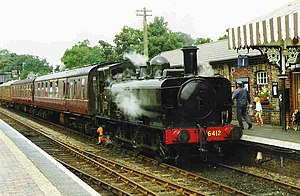GWR 6400 Class
This article needs additional citations for verification. (December 2014) |
| GWR 6400 and 7400 Classes | |||||||||||||||||||||||||||||||||
|---|---|---|---|---|---|---|---|---|---|---|---|---|---|---|---|---|---|---|---|---|---|---|---|---|---|---|---|---|---|---|---|---|---|
 6400 Class No. 6412 arrives at Sheringham, North Norfolk Railway, August 1999 | |||||||||||||||||||||||||||||||||
| |||||||||||||||||||||||||||||||||
| |||||||||||||||||||||||||||||||||
| |||||||||||||||||||||||||||||||||
| |||||||||||||||||||||||||||||||||
The Great Western Railway (GWR) 6400 Class is a class of 0-6-0 pannier tank steam locomotive introduced by Charles Collett in 1932. All 40 examples were 'auto-fitted' – equipped with the remote-control equipment needed for working autotrains.
The 1936 GWR 7400 Class was a similar class, without the autotrain apparatus, but with a higher boiler pressure of 180 psi, providing a small but useful increase in power. An initial build of 30 in 1936-1937 was added to by British Railways in two batches each of ten locos in 1948 and 1950. These were destined for a short life, the briefest being only nine years. A minor visual difference between the 64xx and 74xx classes was at the join between cab and bunker. The 64xx had an arc whereas the later class was straight.
Both classes were closely related to the 1930 GWR 5400 Class, which was in turn an evolution of both the Armstrong 1874 GWR 850 Class and the Dean 1891 GWR 2021 Class. Thus the basic design was almost sixty years old when new, the 4 ft 7+1⁄2 in (1.410 m) driving wheels being the main distinguishing factor, apart from the more modern profile. There were also superficial similarities with the GWR 645 Class as extant in the 1930s, that also had 4 ft 7+1⁄2 in (1.410 m) wheels and 24 in (610 mm) stroke cylinders (and by then pannier tanks and full cabs).
Operations
The smaller wheels of the 64xx's permitted operation in hillier locations than the 5400 Class and allocations were initially to the South Wales valleys.
Engines of class 6400 worked on many of the ex-GWR branch lines in Devon and Cornwall until the early 1960s, when the lines closed or diesel multiple units took over services. Number 6430 was a regular engine on the old Tavistock South branch line and would often run with two autocoaches. No. 6412 was based at Gloucester loco shed and operated the last 'Chalford Shuttle' autotrain service between Gloucester and Chalford in 1962.[1]
Numbering
There were 40 locomotives in the 6400 Class, numbered 6400-6439[2] and 50 locomotives in the 7400 Class, numbered 7400-7449.[2]
Preservation
Three of the 6400 Class have survived to preservation:
- 6412 is operational at the South Devon Railway after a major overhaul was completed in 2015 – star of The Flockton Flyer[3]
- 6430 is operational at the Llangollen Railway after overhaul in 2015
- 6435 is operational at the Bodmin and Wenford Railway after overhaul in 2012
In fiction
A 64xx Class loco (no. 6412) was the title character of the British 1970s TV series The Flockton Flyer, which was filmed on the West Somerset Railway where the preserved locomotive was based. (No. 6412 was relocated to the South Devon Railway in 2009.)
Models
Lionheart manufacture a model of the 64xx in O scale. Bachmann have recently[when?] begun producing models in OO gauge with the numbers 6407 in GWR unlined green, 6417 in BR unlined black and 6412 in BR lined Brunswick Green, with an N gauge version (under the Graham Farish brand) to follow shortly[when?] with the numbers 6407 in GWR unlined green, 6403 in BR unlined black and 6400 in BR lined Brunswick Green.
See also
- GWR 0-6-0PT – list of classes of GWR 0-6-0 pannier tank, including table of preserved locomotives
References
- ^ "6412 - '64xx' class pannier tank locomotive". (Visiting locomotives). Gloucestershire and Warwickshire Railway. Retrieved 2009-01-30.
- ^ a b The Observer's Book of Railway Locomotives of Britain by H C Casserley, Frederick Warne & Co (1958 edition)
- ^ "News from January 2009". ("6412 leaves the WSR"). West Somerset Railway. 8 Jan 2009. Retrieved 2009-01-30.
